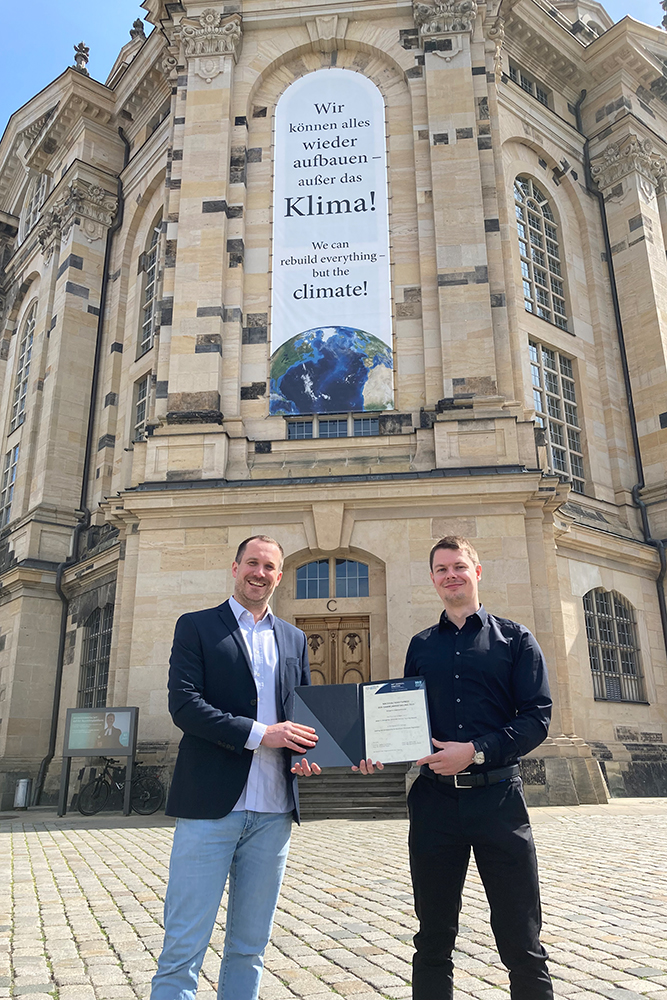Sustainable AI made @TUBraunschweig GAMM Sustainability Award for international research team
A large proportion of the roughly 40,000 bridges on German motorways and federal roads are in poor condition. Thousands will have to be renovated in the coming years. But how can damage to the structures be detected in time? Dr Alexander Henkes and Professor Henning Wessels from the Institute for Computational Modelling in Civil Engineering and Professor Jason Eshraghian from the University of California, Santa Cruz, have developed a digital method that can help maintain bridges more efficiently and extend their service life. For their work, they were now presented with the Sustainability Award worth 1,500 euros at the annual conference of the Association of Applied Mathematics and Mechanics (GAMM) in Dresden.
Thanks to artificial intelligence, measurement data can be analysed and processed in real time. This technology offers a wide range of possible applications in areas such as aerospace, medicine, but also the monitoring of critical infrastructure such as bridges.
However, conventional AI algorithms on classic hardware consume too much energy to be combined directly on components with sensors. This is an obstacle to efficient use. This is where Spiking Neural Networks come into play, which more closely emulate the human brain. For example, the human brain only needs about 20 watts of power to perform complex tasks.
Energy consumption is greatly reduced
The implementation of Spiking Neural Networks on so-called neuromorphic hardware enables a drastic reduction in energy consumption by a factor of 100 to 1,000, and possibly even more. This means an enormous improvement in energy efficiency.
The GAMM award-winning method, which was developed under the leadership of Dr Alexander Henkes and will be presented at the annual conference, deals with machine learning, a sub-field of AI that can be divided into classification (for example, dog/cat/mouse) and regression (the learning of functions). The contribution of this work is to use Spiking Neural Networks, which have so far mainly been used for classification, for regression and thus for applications in scientific computing. This is an important prerequisite for the fields of application already mentioned, such as the monitoring of bridges.
Projects in the Research Training Group and Priority Programme

Dr Alexander Henkes (r.) and Professor Henning Wessels from the Institute for Computational Modelling in Civil Engineering. Photo credit: Henning Wessels/TU Braunschweig
The collaboration with Professor Jason Eshraghian from California came about through a cooperation with Dr Alexander Henkes on the open-source software snnTorch, which has also resulted in tutorials for interested students and researchers. Together they also founded OpenNeuromorphic, an open source community for neuromorphic computing.
The possibilities of the digital method are also being researched in the Research Training Group 2075 “Modelling the constitutional evolution of building materials and structures with respect to aging” of the “Future City” core research area and in the priority programme “SPP 2388 Hundert plus: Verlängerung der Lebensdauer komplexer Baustrukturen durch intelligente Digitalisierung”. The scientists want to develop a method that makes it possible to monitor buildings with currently available measuring principles and to make time-variant condition information available for linking with a digital building twin. In addition to the Institute for Computational Modelling in Civil Engineering, the Institute of Geodesy and Photogrammetry (Professor Markus Gerke), the Institute of Steel Structures (Dr. Julian Unglaub) and the Institute of Building Materials, Concrete Construction and Fire Safety (Professor Dirk Lowke) are involved in this project.
About the Sustainability Award
In light of climate change, scientists are called upon to contribute ideas to promote sustainability. In order to strengthen such activities, the organisers of GAMM100 have created the “Sustainability Award of the GAMM Annual Meeting 2023”. The prize is endowed with 1,500 euros and will be awarded for original scientific contributions at the conference that deal with sustainability issues.
